This is what i originally came here for,” says chef Alessandro Stratta, taking his knife to a corner of the dish beside him. “It’s basically a tortilla with bean puree with roasted chiles and onions and fried beef.”
The dish is called a huarache, Stratta explains in a flawless accent, which means “slipper” or “sandal” in Spanish. It’s flat, like an open-face burrito, just another example of the wonders that can occur when beans and meat unite on top of a tortilla in the right hands. While unusual on Las Vegas menus, huaraches are a popular alternative to tacos or burritos in Mexico City. Indeed, a sign on the outside window of Los Antojos, the shoebox-size restaurant where we’re eating a late lunch, proclaims the locale is “sabor a DF” or “Mexico City style.”
Under walls decked in illustrated maps of Mexico and a TV blaring Mexican game shows, Stratta digs into a miniature feast: the huarache, chicken mole tacos, tacos of cochinita pibil and another handful of tiny corn tortillas filled with chicharrones en salsa verde (pork rinds).
“Lo que no les gusten, nos dicen. Y lo corregimos,” says Carmen Ruíz, head chef and mother of the restaurant’s owner, Adiana Martínez, as she hovers over us pointing out what we are about to eat. Tell us what you don’t like, and we’ll fix it. It’s an easy offer to make at the 14-year-old, family-run restaurant. Ruíz knows there’s nothing to correct.
More
- Food Issue
- Las Vegas is still hungry
- Man vs. big food
- Man vs. live sushi
- Man vs. hot thai
- Robuchon on $89 a night
- Pass the crab legs! A trip through Vegas' buffets
- Anatomy of a dish: The Fat Elvis
- Related Stories
- Video: Alex on Alex (10/23/08)
- AAA graces Vegas with Five Diamond ratings, again (11/14/08)
- Restaurant Guide
- Alex
- Stratta
What she doesn’t know, at least Stratta doesn’t think so, is whom she’s serving. A few miles away at the Wynn, Stratta is the man behind two restaurants—the luxurious Alex, which serves the cuisine of the French Riviera in an elegant dining room, and Stratta, a more casual eatery that emphasizes Italian-American flavors and wood-fired pizzas. He’s trained under Alain Ducasse and Daniel Boulud and won a James Beard Award. Here, in a strip mall on the corner of Eastern and Sahara avenues, however, he is just another Spanish-speaking patron appreciating the flavors of the rich, spicy mole and cochinita pibil with pickled onions.
“It has all kinds of great technique,” he says admiringly after a bite of the tender, shredded pork known as cochinita pibil. “It’s important to know how to cook it and the right spice mix. Generally, it’s baked pork with adobo spices and chiles and garlic. And it’s cooked in hojasanta [banana leaves].”
Los Antojos, a favorite off-Strip stop when Stratta wants a quick, inexpensive snack, might seem the opposite of his own properties. We’re sitting on small plastic chairs that resemble the ones used in elementary schools, after all, and there isn’t a wine list, let alone a sommelier. Instead of a bustling crew of professional servers, a mix of family members and staff are lounging behind the counter during what Stratta says is an unusual lull. The service is prompt and unobtrusive, the vibe casual in the extreme, and Ruíz patrols the restaurant like a watchful grandmother.
“Está esquísito el mole. De verdad,” Ruíz tells us—the mole is terrific. Really.
She extorts us to dig in. “Coman, por favor.”
Ruíz and her family moved to Las Vegas from Mexico City in 1994, a year before opening Los Antojos. Stratta, too, cooks the flavors of his family. His mother is French, his father Italian, and his restaurants’ dishes mirror their heritage. But while you won’t find guacamole or gorditas among their menus, one of his first gastronomic loves was Mexican food, particularly the tortas, flautas and taquitos served at a restaurant called Chula Vista in Acapulco.
“I lived in Mexico from the age of 6 to 10,” explains Stratta between bites of taco. “My dad opened the Acapulco Princess in 1969, and we left, I think, in ’74. It was, like, the hotel at the time.”
The son of a hotelier, Stratta, along with his sisters, bounced around the globe for the first years of his life. Born in Wisconsin, where his father was doing graduate work at Marquette University, Stratta had lived in four other countries by the time the family landed in Mexico: Malaysia, Singapore, Indonesia and Pakistan. “I lived in hotels until I was 14,” says Stratta.
On the Acapulco Princess property was Chula Vista. “We ate mostly in the restaurants—breakfast, lunch, dinner, room service. You know, my mom’s a good cook and everything, but we cooked mostly on special occasions.”
These days, an afternoon away from the kitchen is a special occasion for the acclaimed chef, who was named the Best Chef in the Southwest by the James Beard Foundation in 1998 and has earned two Michelin stars and an AAA Five Diamond Award at Alex.
But there was a time when Stratta had no intention of donning chef’s whites for a career in the kitchen.
“My first job ever was a Wendy’s. I made Frosties and cleaned the walk-ins,” he remembers, chuckling.
Eventually, Stratta would venture west. He’d do a brief stint at Regis University in Denver, studying political science, or “nothing,” as he puts it, and he’d briefly consider becoming a ski instructor. It wasn’t until he’d already completed culinary school and had moved to Monaco for an apprenticeship that the light turned on.
“The Louis XV, Alain Ducasse’s first restaurant, was opening at the time, so they asked me to help out there,” Stratta recalls. “Well, they told me to work there, and that’s where I first got into savory food. That’s where I got hooked.”
Hooked involved learning the exacting manner in which the restaurant performed every single task.
“I used to clean squid to no avail. I mean, these little tiny squid,” Stratta holds up his thumb and forefinger a few inches apart, “that were apparently better than the ones that were this big. I would do that three or four hours a day every day.” He laughs. “The American gets the squid.”
Today, the same exacting standards are employed at Stratta’s own restaurants, but he says that when you get past the elaborate décor and presentations, the food he serves isn’t all that different from the simple, delicious dishes crowding the table at Los Antojos.
“[Alex is] founded in very basic traditional cooking. You’re not just all fluffy stuff that doesn’t taste like anything. If there’s some kind of new technique to make the skin crispier, I’ll do that, but I still serve basically the piece of meat or fish.”
Some of the ingredients and techniques are different—I can’t imagine Los Antojos has started cooking sous vide—but ultimately, it’s closer to inches than miles.
“I don’t know how many of my guys in the kitchen could make [the cochinita pibil],” Stratta offers. On the other hand, he has confidence in Ruíz’s ample cooking skills.
“I’m sure if I put her in my kitchen, she’d be just fine. She obviously knows how to cook. That’s universal—basic cooking techniques and paying attention and keeping traditional with seasonal fresh ingredients.”
The sounds of sizzling meat echo out of the tiny kitchen as a family settles in at the table next to us.
“I think if you served this food in a trendy, hip, happening place on the Strip, you’d be packed,” Stratta continues. The huaraches range from $4.99 to $7.99 depending on the protein used; you could probably sell them for three times as much, he guesses.
“This is just good solid food. No additional adornments. Just good.”
When company comes over, Stratta says he likes to make his own green mole, rice and beans—a simple, filling meal.
I suggest that he should open up his own Mexican restaurant, and Stratta laughs.
“Sure, I’d love to,” he says, smiling past me at the wall. And he can see it already. “A tequila bar and all types of Mexican beers … some music …”
Alex Stratta's Porcini Risotto
Ingredients:
3 cups Vialone Nano rice
1 cup white onion
6 tablespoons dried porcini mushrooms (chopped)
3 tablespoons butter
1 ¾ cups dry white wine
10 cups white chicken stock
6 tablespoons butter
¾ cup grated Parmigiano Reggiano cheese
Salt and pepper
Method:
For the risotto:
First place the chicken stock in a saucepan and bring to a simmer. In another heavy saucepan, melt the first 2 tablespoons of butter over low heat and add the finely diced onion and season slightly with salt. Sweat onions at low heat for approximately 8 to 10 minutes, or until soft and translucent.
Add the rice and coat well with the butter and onion mixture. Season again and turn the heat to medium. Stir the rice until it begins to crackle and add the dried porcini mushrooms. At this point, add the white wine and bring to a simmer. Stir the rice until all of the liquid is evaporated. Add enough stock to cover the rice and continue to stir until all the liquid is, again, evaporated. Repeat step four more times. The final "wetting" should not reduce all the way to dry. At this point, the rice should be slightly al dente, loose and creamy and bring to a slow boil. Taste the rice for texture and seasoning. The rice should be firm on the tooth, but not hard. Add the grated cheese and stir the remaining butter into the rice in the final step. What should result is a rich, creamy, pudding-like risotto.
Ingredients:
For the garnish:
3 cups fresh porcini mushrooms
2 teaspoons diced shallots
2 tablespoons olive oil
3 tablespoons butter
3 tablespoons chopped Italian parsley
Salt and pepper to taste
Method:
Peel and pare the mushrooms, cutting them into ½-inch thick segments. Heat the oil in a heavy sauté pan over high heat and allow the oil to smoke lightly. Add the mushrooms and color to light golden brown. Add the butter and shallots and sauté while the mushrooms continue to brown and the shallots become translucent. Season and finish with chopped parsley. Reserve warm until needed.
Finishing the dish:
6 each thin shavings of Parmigiano cheese
2 tablespoons extra virgin olive oil.
Divide the rice into four separate bowls and garnish with sauté of porcini mushrooms and shavings of cheese, then finish with a drizzle of the olive oil.
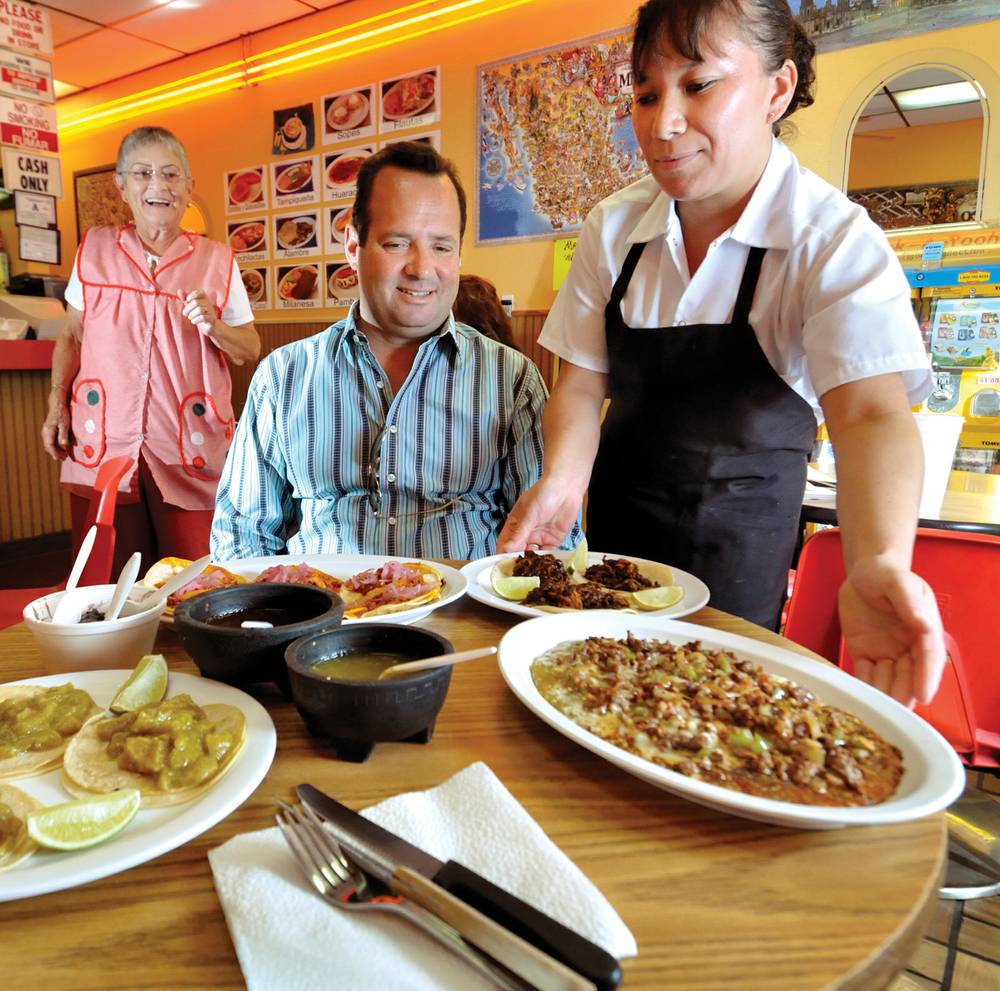
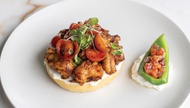
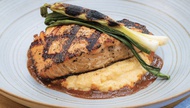
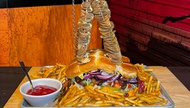

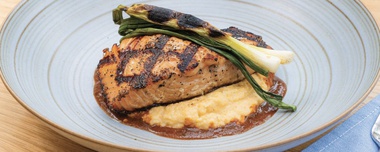
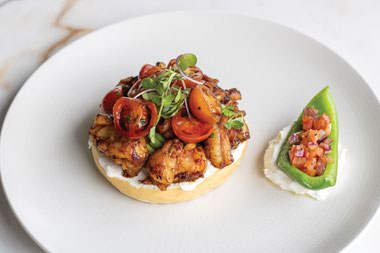

Previous Discussion: